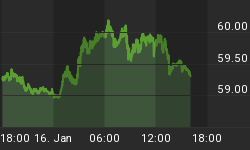Some times it is worthwhile to stand back and take a long term perspective. Get rid of most of the indicators, pull out the monthly charts and have a look around. The monthly charts definitely cut out the noise, and often times offer a fresh perspective as to where the market is going. While the price action in and of itself won't tell you what is driving the market, a lot of times the monthly charts may show you the important bigger picture.
Today's exercise is just that- an exercise. It is my interpretation of the monthly charts in key markets. I am using one indicator and some trend lines. There is nothing systematic or mechanical or computerized back testing about this analysis; it is just me looking at the charts trying to determine where key junctures may occur. By identifying where key junctures may occur on the monthly charts, I can be on the lookout for new trends or new intermarket relationships that may cause continuation of or changes in the trend. This is simple but valuable analysis.
The price graphs are constructed in the following manner: 1) over the price graph is the standard Bollinger Band indicator; 2) the bottom plate is a normalized Bollinger Band. Normalizing the indicator means that the bottom band is set to zero and the top band equals one; the indicator (in red) is the value of the closing price in relationship - percent wise- to the upper and lower bands.
Figure #1 is a monthly chart of the US Dollar Index. Back in 2002, the Dollar came out of low volatility squeeze (narrowed Bollinger Bands and shaded oval on chart) and broke to the downside breaking the long term trend line, AB (see blue arrow on middle panel). The trend line EF defines a positive divergence between price and the indicator. Prices are heading higher. The first target would be the down trend line CD (around $93); a secondary target would be the bottom of trend line AB which also coincides with the halfway point of the indicator or the 20 day moving average (middle band) of the Bollinger Band. This number currently is at $95.
Figure #1/ US Dollar/ monthly
Why is this important? Well if the dollar is headed higher than the metals and commodities in general are headed lower. But it appears that the dollar may run into some resistance shortly, and this may represent a key turning point where the metals find their footing and head higher. Let's look at gold.
Figure #2 is a monthly chart of Gold. The break in prices in gold coincided with the break in the indicator at trend line AB (see blue arrow on chart). Trend line EF shows the negative divergence between price and indicator prior to the change in trend. Where is gold headed? The first stop would be the middle Bollinger Band line at $371. This also coincides with a 38% retracement level of the entire move as seen from trend line GH. If this doesn't hold, then the next stop would be trend line CD; this I believe would correspond to about the $350 level; interestingly, a 50% retracement in gold, as represented by trend line GH, would bring prices to about the $350 level.
Figure #2/ Gold (continuous contract)/ Monthly
The next graph (figure #3) will be the only weekly chart that I will look at, and it is the CRB Index. The break of trend line AB will most likely result in a bounce off the long term up trend line CD. This should come in around at $260, which is the point of the last "breakout" in prices (orange line on graph), and corresponds to a 38% retracement of the price move defined by trend line EF.
Figure#3/ CRB Index/ weekly
From the charts, it appears that the dollar- commodity- gold complex may be approaching a key juncture. At these times, I will drill down utilizing daily and weekly charts to ascertain which direction the trend most likely will go.
Later in the week, I will give my interpretation of the Dow, NASDAQ, and 30 year bond.
The Technical Take
$ monthly charts of Dollar- Commodity- Precious Metal complex suggest a turning point could be near or a continuation/ acceleration of the existing trend
Thanks for reading and I hope you have found my analysis informative, insightful and profitable....
If you would like more information regarding my methodologies, please contact me at blueguyzee@yahoo.com.
















